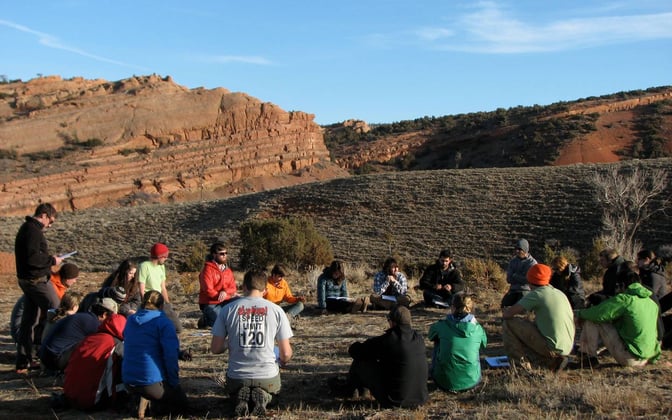When it comes to outdoor organizations, risk management should always be a top priority. Whether you're leading wilderness adventures or running educational programs in the outdoors, risk management is an essential aspect of your operations.
But how can you create an effective risk management culture within your organization that truly prioritizes transparency and learning?
 Photo by Marcio Paes
Photo by Marcio Paes
Follow along to learn how NOLS approaches the importance of prioritizing a risk management culture and the role of incident reporting within that culture, providing you with a comprehensive approach to cultivating a stronger risk management culture for your outdoor organization.
Understanding Risk Culture in an Outdoor Setting
Risk management culture is more than just a buzzword—it's a critical aspect of how your organization thinks, acts, and interacts when it comes to preventing, managing, and responding to risk. It's the collective attitudes and behavior norms around risk that define your organization’s risk culture. When an incident occurs, whether it's a minor scrape or a near miss, how your organization responds to it reflects your risk culture.
Is your organization's culture one that embraces transparency, learning, and accountability, or does it shy away from these crucial elements?
Does it encourage open reporting and a fair assessment of what happened, or does it foster an environment of blame and fear?
These are the questions your risk culture answers, and its responses leave a lasting imprint on your organization's identity.
At NOLS, we've dedicated ourselves to not only understanding but also nurturing the kind of risk culture that thrives in outdoor settings. We believe that by fostering an environment where risk awareness, transparency, and learning are paramount, organizations can transform their outdoor adventures into truly exceptional and enriching experiences for both clients and staff.
After all, in the wilderness and beyond, risk culture isn't just a concept—it's the compass that guides you toward safer horizons and richer discoveries.
The Power of Incident Reporting in Outdoor Organizations
 Photo by Trip Davis
Photo by Trip Davis
One of the cornerstones of a healthy risk culture is a sound incident reporting system.
This system should foster transparency, encourage learning and open reporting, and provide a structured way to address incidents, both minor and major.
Benefits of a Sound Incident Reporting System
- Evidence-Based Practices: Incident data is essential for developing evidence-based field practices. It allows you to create a statistical database for analysis, identify trends, and predict future problem areas.
- Data Over Anecdotes: With data in hand, you no longer need to rely on anecdotal accounts and myths. Instead, you can focus on known and documented risks and areas of concern.
- Tailored Training and Policies: Organizations can gain a better understanding of which types of incidents and injuries are most common. This knowledge enables you to modify training programs and policies accordingly.
Fostering a Just Risk Management Culture
 Photo by Theresa Silveyra
Photo by Theresa Silveyra
In a healthy risk management culture, people should feel good about reporting incidents without fear of retribution. Acknowledging incidents and any resulting harm, whether they result from human error, accidents, or other factors, provides an opportunity to learn and improve.
Accountability vs. Blame
People in a healthy risk management culture should feel that they can report an incident and bring forward information that will contribute, without retribution, to organizational learning.
At NOLS, we prioritize accountability over blame to improve risk culture and encourage transparency and learning.
Seeking blame inhibits accountability. If individuals believe they will be punished or shamed for an incident, they are less likely to come forward with reports, hindering the improvement process.
Dismissing an employee may be an appropriate response in some cases but should come after careful analysis within a just risk culture.
Seven Steps to Implementing an Effective Incident Reporting System to Improve Risk Culture
 Photo by Oscar Manguy
Photo by Oscar Manguy
Creating an effective risk culture starts with implementing a reliable incident reporting system. Here are seven steps to help you get started:
1. Design a Simple Incident Report Form
Keep the incident report form simple and straightforward. A complex form with too many questions can be seen as burdensome and deter compliance.
2. Define a Reportable Incident
Clearly define what constitutes a reportable incident. Not every minor injury or incident needs to be recorded. Focus on injuries, illnesses, near misses, and any behavior incidents that are relevant to your program.
3. Capture the Story
Include a narrative section on the incident report form. Writing good incident narratives takes instruction, training, and practice. Ensure that narratives are concise, factual, descriptive, and present a clear picture of the event.
4. Collect Program Day Information
Gather participant data to calculate incident rates. Incident rates are essential pieces of risk information that provide insights for measuring performance over time. Typically, these rates are measured as incidents per 1,000 program days.
5. Have Accessible Data
Design a storage system that allows for easy data retrieval. Consider using database software or statistical tools like FileMaker Pro® for this purpose.
6. Analyze the Data
Regularly analyze incident data to identify patterns, frequent incidents, and contributing factors. Look for trends in incident rates over time, by season, or during specific activities.
7. Close the Feedback Loop
Foster an organizational culture that embraces learning from incidents. Encourage reporting by using the information responsibly. Avoid punitive measures and instead demonstrate the value of incident reporting to your staff by reporting on significant learnings and trends from the incident data.
Develop Your Organization's Risk Management Culture with NOLS
At NOLS, we offer risk management training courses and services that include consulting and training for outdoor, adventure, and education programs in various risk management areas designed to improve your organization's overall risk management effectiveness.
Our goal is to help and support you in taking a closer look at your organization's current risk culture and creating the desired culture of accountability, preparedness, and awareness, where incident reporting is an essential tool for learning and improving your organization's risk culture and risk management practices.
Cultivating a risk management culture within your outdoor organization is a journey that starts with implementing an effective incident reporting system. By fostering a culture of transparency, learning, and accountability, you can create a better environment for your clients and staff, ultimately enhancing the quality of the outdoor experiences you offer.
Remember, managing risk is not just a priority; it's a core value that should guide every adventure and educational program you offer.
Written By
NOLS
NOLS is a nonprofit global wilderness school that seeks to help you step forward boldly as a leader.




